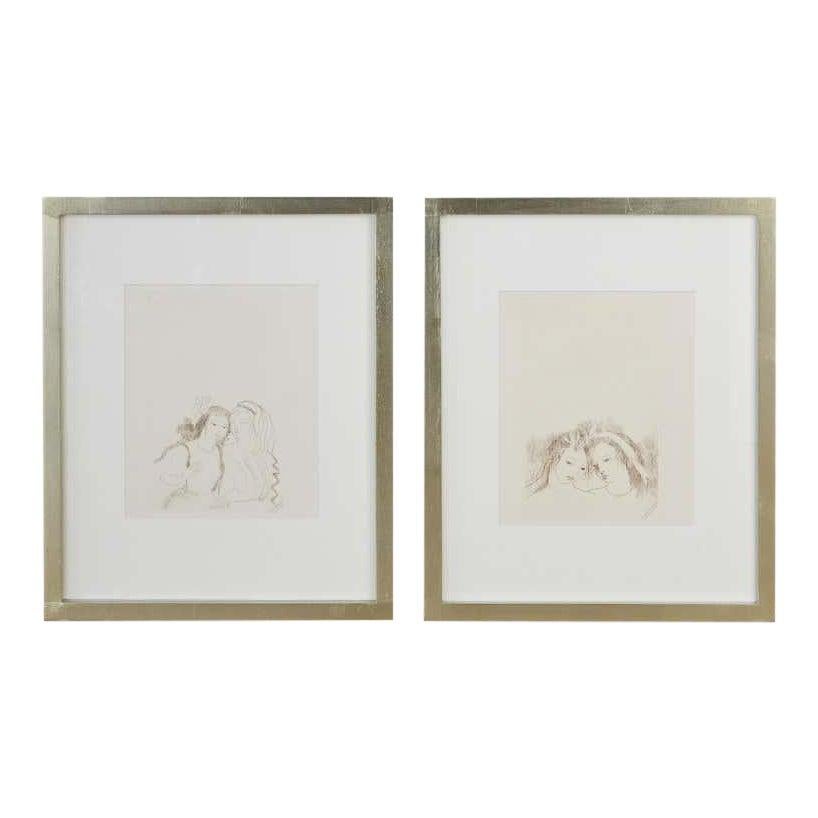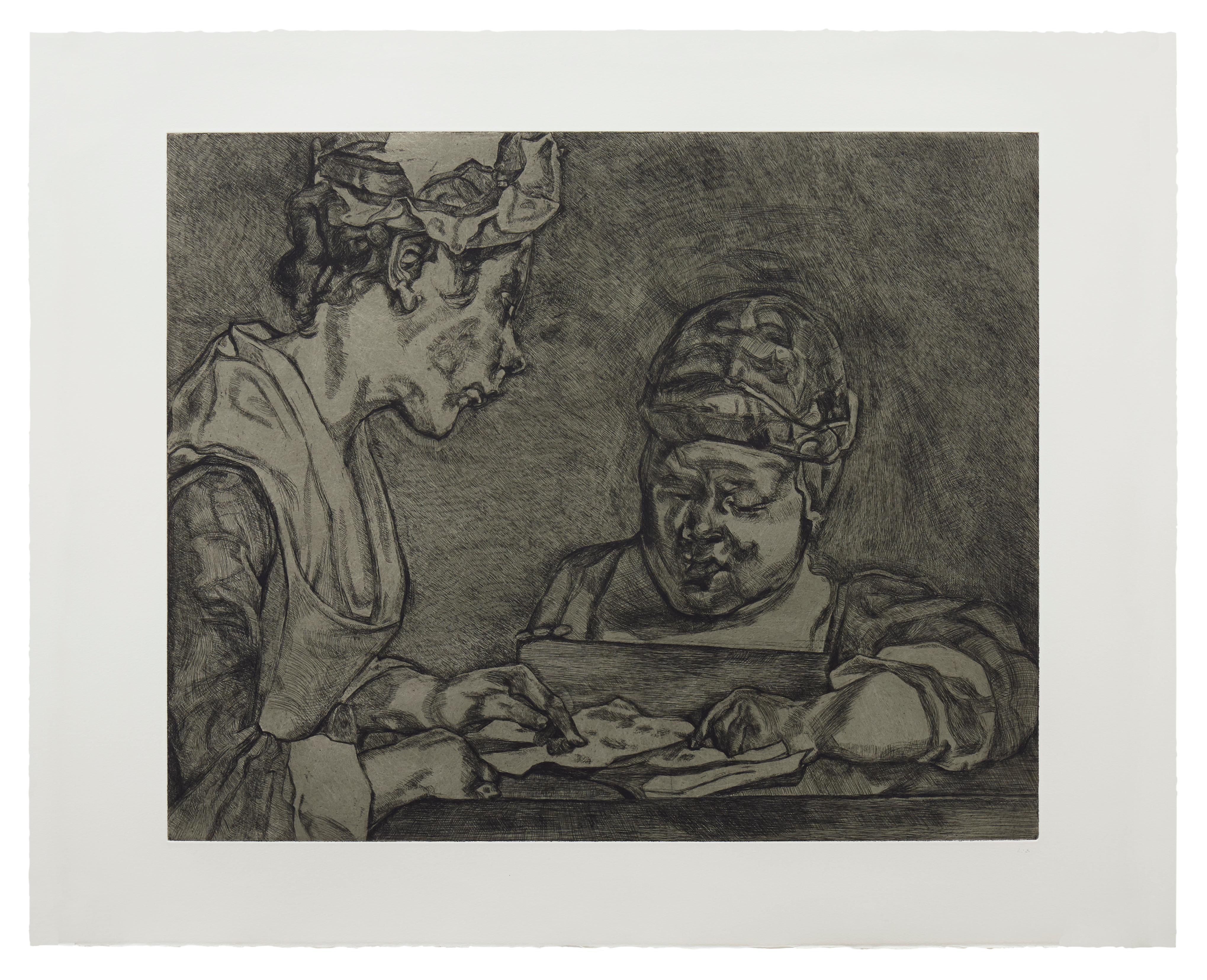Items Similar to The Fisherman - Etching on Cardboard by Giovanni Omiccioli - 1971
Want more images or videos?
Request additional images or videos from the seller
1 of 3
Giovanni OmiccioliThe Fisherman - Etching on Cardboard by Giovanni Omiccioli - 1971 1971
1971
About the Item
The Fisherman is an original etching hand colored by the italian artist Giovanni Omiccioli in 1971.
Hand-signed in pencil on the lower right and dated. Numbered on the lower left, edition of XIV/XXX prints.
In very good conditions
Sheet dimensions: 35 x 23.5 cm.
On the back of the print, Imprint of the print engraved with the etching technique and notions on the work itself.
Giovanni Omiccioli was an Italian painter belonging to the modern movement of the Scuola romana with dynamic paintwork. Having joined the Scuola Romana movement, in 1928, Omiccioli collaborated especially with Mario Mafai and Antonietta Raphael, as well as with Scipione and Raffaele Frumenti. His pictorial activity started in 1934 and a few years afterwards, he exhibited work at the IV Mostra del Sindacato Fascista (1937) within the Fine Art circle. In the same period he held his personal expo at Apollo Gallery in Rome.
Omiccioli was also active in politics and, with Mario Mafai, Guttuso and Afro, he created the first header of the Italian communist newspaper L’Unità in 1945, immediately after the Italian Liberazione. During the same year he exhibited at the I Mostra dell’Arte against barbarism, promoted by this newspaper at the Gallery of Rome with catalogue by Antonello Trombadori, presenting a dramatic political painting by the title “La fucilazione di Bruno Buozzi”.
After winning an award at the Marzotto Prize Convention, with “Il Pastore con la capretta”, Omiccioli exhibited at many important art centers: especially noticeable are his anthological displays at the Hermitage of Leningrad, his personal at the La Medusa Modern Gallery of Naples, and in the 1950s his participation in exhibitions at Pittsburgh, Boston, and Tokyo. He also took part in a travelling exhibition around the Scandinavian countries organised by the Italian Art Club, as well as displaying some paintings at the various Rome Quadriennale of 1955, 1959 e poi del 1966, and at the Venetian Biennale of 1952, 1954, 1956. In 1959 he also presented a religious painting on hardboard, Cristo crocifisso (Crucified Christ), at the VIII Biennale d’Arte Sacra in Bologna. During the 1960s, Omiccioli exhibits at three Figurative Arts Reviews in Rome and Lazio (1961, 1963, 1965) and at the VI Biennale of Rome in 1968.[3] Vaporous and tender, and yet always springing from an unchangeably intense love for nature and man, his palette of colours give a soft breath of light and a suggestive atmosphere to his whole artistic production.
- Creator:Giovanni Omiccioli (1901 - 1975, Italian)
- Creation Year:1971
- Dimensions:Height: 3.75 in (9.5 cm)Width: 5.63 in (14.3 cm)Depth: 0.04 in (1 mm)
- Medium:
- Period:
- Framing:Framing Options Available
- Condition:Insurance may be requested by customers as additional service, contact us for more information.
- Gallery Location:Roma, IT
- Reference Number:
About the Seller
4.9
Platinum Seller
These expertly vetted sellers are 1stDibs' most experienced sellers and are rated highest by our customers.
1stDibs seller since 2017
6,717 sales on 1stDibs
Typical response time: 2 hours
- ShippingRetrieving quote...Ships From: Rome, Italy
- Return PolicyA return for this item may be initiated within 14 days of delivery.
More From This SellerView All
- Profile - Original Etching by Giacomo Porzano - 1972By Giacomo PorzanoLocated in Roma, ITProfile is an original modern artowork realized by the Italian artist Giacomo Porzano (1925-2006) in 1972. Black and white etching. Hand-signed and dated on the lower right. Numbe...Category
1970s Contemporary Portrait Prints
MaterialsEtching
- Birds - Original Etching by Benn - Mid-20th CenturyLocated in Roma, ITGirl at the Window is an original Etching realized by Benn (Bencjon Rabinowicz) in the Mid-20th Century. Hand signed on the lower right margin Go...Category
1950s Modern Figurative Prints
MaterialsEtching
- Profile - Etching by Giacomo Porzano - 1972By Giacomo PorzanoLocated in Roma, ITProfile is a modern artwork realized by the Italian artist Giacomo Porzano (1925-2006) in 1972. Black and white etching. Hand-signed and dated on the lower right. Numbered on the ...Category
1970s Contemporary Portrait Prints
MaterialsEtching
- Portrait of a Child - Original Etching by L.-P. Moretti - Mid-20th CenturyBy Lucien Philippe MorettiLocated in Roma, ITPortrait of a Child is a splendid Etching and drypoint realized by the French artist Lucien-Philippe Moretti in 23 numbered and signed specimens. Outside the matrix the artwork is s...Category
1950s Modern Figurative Prints
MaterialsEtching
- Girl at the Window - Original Etching by Benn - 1987Located in Roma, ITGirl at the Window is an original Etching realized by Benn (Bencjon Rabinowicz) in 1987. Hand signed on the lower right margin. Numbered. Edition ...Category
1980s Modern Figurative Prints
MaterialsEtching
- Portrait - Etching by George Gorvel - 19th CenturyLocated in Roma, ITPortrait is an original modern artwork realized by George Gorvel in the 19th Century. Black and white etching. The artwork is depicted through soft strokes in a well-balanced compo...Category
19th Century Modern Figurative Prints
MaterialsEtching
You May Also Like
- "Two Women" Pair EtchingsBy Marie LaurencinLocated in Rio Vista, CAElegant pair of etchings by Marie Laurencin (French 1883-1956) from the "Poemes de Sapho" published in 1950 ref. 273. Each beautifully mounted in fram...Category
20th Century Modern Portrait Prints
MaterialsEtching
- General Wilhelm von Blume - Visionary retrospective -Located in Berlin, DEBernhard Pankok (1872 Münster - 1943 Baierbrunn), General Wilhelm von Blume, 1915, aquatint etching, 34 x 29.5 cm (sheet size), 26 x 22 cm (plate size), signed in the plate at upper left, in pencil at lower right and dated in pencil at lower left. - At lower left old collection stamp, at the right broad margin with a small spot, otherwise very good condition. About the artwork The 1915 aquatint etching of General Wilhelm von Blume is based on a 1912 oil painting in the LWL-Museum für Kunst und Kultur in Münster. A second oil portrait of the general by Pankok is in the Staatsgalerie Stuttgart. When Pankok painted the first oil portrait in 1912, the general had already been retired for 16 years. It is therefore a retrospective portrait. Accordingly, the orientation of his head is such that he is looking back in both the oil painting and the etching. Without fixing on anything in particular, he looks thoughtfully inwards and reflects on his life. Uniformed and highly endowed, it is his military activities in particular that he is reviewing attentively and, as his gaze reveals, quite critically. Pankok has literally written the sum of his experiences on Wilhelm von Blume's face: The physiognomy is a veritable landscape of folds, furrows, ridges and gullies, all the more striking against the flat background. It is clear that each of the medals was also won through suffering. However, by breaking the boundaries of the picture, his bust appears as an unshakable massif, which gives the general a stoic quality. The fact that the design of the portrait was important to Pankok can be seen from the different versions, the present sheet being the third and probably final revision, which Pankok dates precisely to 18 February 1915. Compared with the previous state, the light background now has a dark area against which the sitter's face stands out, the dark background in turn combining with the uniform to create a new tension in the picture. Pankok's taking up of the portrait of the high-ranking military veteran and its graphic reproduction can also be seen in relation to the First World War, which had broken out in the meantime. In the face of modern weapons of mass destruction, Wilhelm von Blume's warfare and military writings were relics of a bygone, more value-oriented era. About the artist After studying at the Düsseldorf Art Academy from 1889 to 1891 under Heinrich Lauenstein, Adolf Schill, Hugo Crola, and Peter Janssen the Elder, Bernhard Pankok went to Munich in 1892, where he worked primarily as a graphic artist for the two major Jugendstil magazines "Pan" and "Jugend," which established his artistic success. Through this work he met Emil Orlik, with whom he had a lifelong friendship. In 1897, he exhibited his first furniture, and in 1898, together with Richard Riemerschmid, Bruno Paul and Hermann Obrist...Category
1910s Realist Portrait Prints
MaterialsEtching
- Half-length portrait of a man with beard - A Rembrandt of the 18th century -Located in Berlin, DEJohann Friedrich Bause (1738 Halle a. d. Saale - 1814 Weimar). Half-length portrait of a man with beard and cap after a drawing by Christian Wilhelm Ernst Dietrich. Etching and coppe...Category
1780s Baroque Figurative Prints
MaterialsEtching
- Balaclava - The target in sight -Located in Berlin, DEHeinrich Haberl (1869 Passau to 1934 Munich), Sturmhaube, c. 1900. drypoint, 14 x 10 cm (platemark), 28 x 21 cm (sheet size), 39 x 29 cm (passe-partout), titled "Sturmhaube" in lead at lower left and inscribed "Kaltnadelradierung", signed and locally inscribed "Heinrich Haberl Mchn. [Munich]" at lower right, inscribed again in lead on verso and with old collection stamp. - slightly darkened, fixed and mounted - The target in sight - About the artwork The theatrical "role-portrait" is to be seen against the background of the Rembrandt cult, which reached its climax at the end of the 19th century. The soldier seems to have stepped straight out of Rembrandt's Night Watch (1642) to fix something outside the picture with an alert and ready gaze. The steeply rising brim of the morion frames the gaze and thus perspectivises it as the actual 'pictorial action'. The gaze represents both the vigilant defence and the visionary goal of the battle. Not only the subject, but also the style of the etching needle reflect Rembrandt's understanding of the times. Strong contrasts of light and dark are created in a virtuoso free stroke, without losing the effect of the reflections on the helmet and in the eyes. This shows a kinship with the early prints of Lovis Corinth, who also saw himself as an artist in the role of the knight. Against this background, Haberl's picture can also be seen as a representation of his artistic self-image. About the artist Heinrich Haberl first attended the art school in Nuremberg and from 1892 studied at the Munich Academy. There he was a master student of Johann Leonhard von Raab, Rudolf von Seitz, Franz von Defregger...Category
Early 19th Century Realist Figurative Prints
MaterialsEtching
- Portrait HeadBy Lucian FreudLocated in New York, NYLucian Freud Portrait Head 2001 Etching on Somerset Textured White paper 28 1/2 x 22 1/2 inches; 72 x 57 cm Edition of 46 Initialed and numbered in graphite (lower recto) Frame available upon request Published by Matthew Marks Gallery...Category
Early 2000s Contemporary Portrait Prints
MaterialsEtching
- After ChardinBy Lucian FreudLocated in New York, NYLucian Freud After Chardin 2000 Etching on White Somerset Textured Paper 30 3/4 x 37 3/4 inches; 78 x 96 cm Edition of 46 Initialed and numbered in graphite (lower recto) Frame available upon request Published by Matthew Marks Gallery...Category
Early 2000s Contemporary Portrait Prints
MaterialsEtching
Recently Viewed
View AllMore Ways To Browse
Medusa Print
Scandinavian Original Painting
Christ Etching
Modern Afro
Breath Of Spring
Scandinavian Painting Print
1950s Scandinavian Painting
Crucified Christ
Vintage Headers
Vi Spring
Cristo Prints
Mario Mafai
Scuola Romana
Antonietta Raphael
Antonietta Raphael Mafai
Giovanni Omiccioli On Sale
Framed 19th Century French Fashion
Grand Dame




